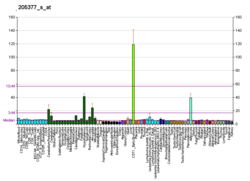
Back إستيراز الأسيتيل كولين Arabic Ацетилхолинестераза Bulgarian ཨེ་སི་ཊིལ་ཁོ་ལི་ནེ་སི་ཊེ་རེ་སི་སྨིན་རྫས། BO Acetilholinesteraza BS Acetilcolinesterasa Catalan Acetylcholinesteráza Czech ACHE CY Acetylcholinesterase Danish Acetylcholinesterase German Acetilcolinesterasa Spanish
| acetylcholinesterase | |||||||||
|---|---|---|---|---|---|---|---|---|---|
Acetylcholinesterase catalyzes the hydrolysis of acetylcholine to acetate ion and choline | |||||||||
| Identifiers | |||||||||
| EC no. | 3.1.1.7 | ||||||||
| CAS no. | 9000-81-1 | ||||||||
| Databases | |||||||||
| IntEnz | IntEnz view | ||||||||
| BRENDA | BRENDA entry | ||||||||
| ExPASy | NiceZyme view | ||||||||
| KEGG | KEGG entry | ||||||||
| MetaCyc | metabolic pathway | ||||||||
| PRIAM | profile | ||||||||
| PDB structures | RCSB PDB PDBe PDBsum | ||||||||
| Gene Ontology | AmiGO / QuickGO | ||||||||
| |||||||||
Acetylcholinesterase (HGNC symbol ACHE; EC 3.1.1.7; systematic name acetylcholine acetylhydrolase), also known as AChE, AChase or acetylhydrolase, is the primary cholinesterase in the body. It is an enzyme that catalyzes the breakdown of acetylcholine and some other choline esters that function as neurotransmitters:
- acetylcholine + H2O = choline + acetate
It is found at mainly neuromuscular junctions and in chemical synapses of the cholinergic type, where its activity serves to terminate synaptic transmission. It belongs to the carboxylesterase family of enzymes. It is the primary target of inhibition by organophosphorus compounds such as nerve agents and pesticides.
- ^ a b c GRCh38: Ensembl release 89: ENSG00000087085 – Ensembl, May 2017
- ^ a b c GRCm38: Ensembl release 89: ENSMUSG00000023328 – Ensembl, May 2017
- ^ "Human PubMed Reference:". National Center for Biotechnology Information, U.S. National Library of Medicine.
- ^ "Mouse PubMed Reference:". National Center for Biotechnology Information, U.S. National Library of Medicine.






